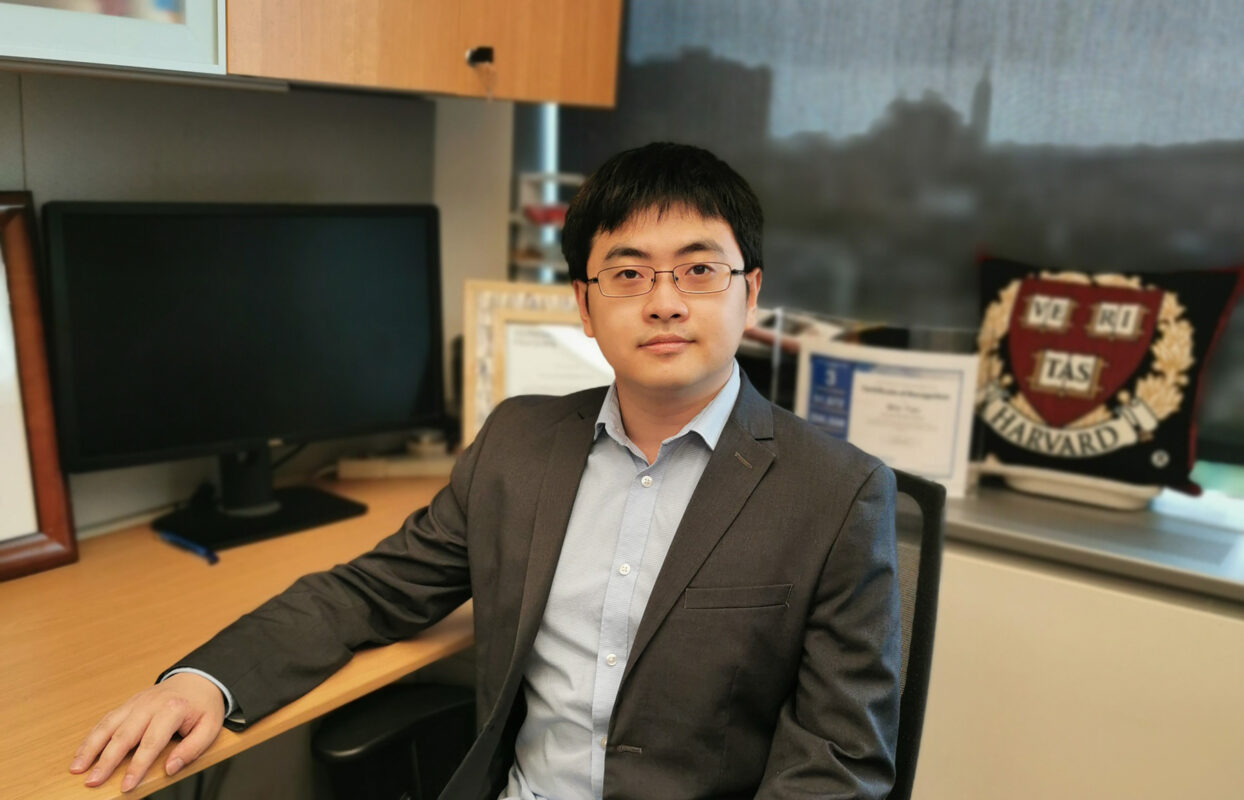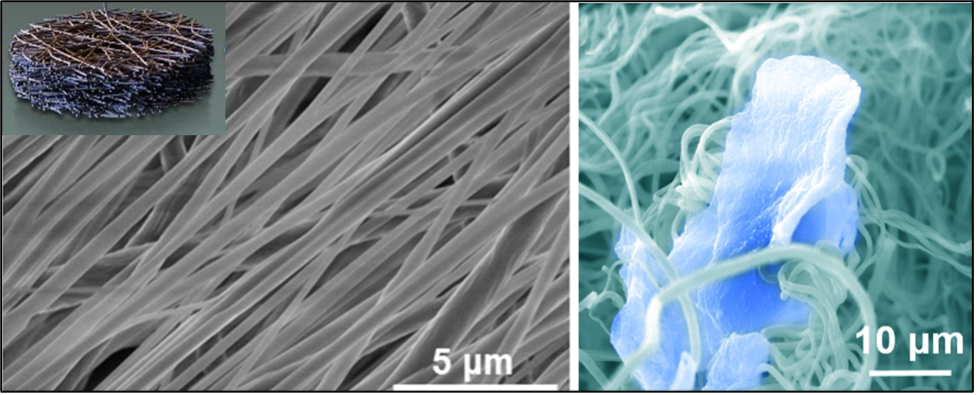
How Can We Fix It? Bio-Inspired Strategies to Improve Patient’s Lives
Stepping Strong Breakthrough Awardee Wei Tao, PhD, is the Farokhzad Family Distinguished Chair for Innovation, a Principal Investigator in the Center for Nanomedicine, and a faculty member in the Department of Anesthesiology, Perioperative, and Pain Medicine at the Brigham. In this interview, Dr. Tao talks to Donna Woonteiler about his passion for the design and synthesis of functional biomaterials and their application in translational medicine.
Q: Thank you for speaking with me today, Dr. Tao. Before we get into the details of your research, I want to congratulate you on being named to Clarivate’s highly cited researchers list for the second consecutive year.
WT: Thank you. This honor is achieved through the efforts of all my team members, including my lovely and hardworking postdocs, students, collaborators, and co-authors. Many thanks to all the fellow researchers who are citing us. We only publish ideas and studies worth spreading, and I sincerely hope people who read our papers will gain new knowledge and feel more hopeful.
Q: Can you tell us about your background and how your training impacted your career choices?
WT: I was born in Suzhou, a beautiful and classical city in Jiangsu, China. I obtained my bachelor’s degree in biomedical engineering at Huazhong University of Science and Technology. After completing my undergraduate studies, I became a PhD student to get additional scientific training at Tsinghua University and Harvard University.
During this period, I received a precious opportunity to join one of the world’s leading laboratories in the biomaterials and drug delivery field. I was fortunate to collaborate with the leading experts at MIT, MGH, Brigham, Boston’s Children’s Hospital, Columbia University, and other institutes to develop biomaterials-based drug delivery solutions.
Q: Who were your role models as you pursued your research passions?
WT: Two extraordinary role models inspired my passion and dedication to this research field: Professors Omid Farokhzad at BWH and Harvard, and Robert Langer at MIT. Not only have their cutting-edge studies in drug delivery systems, biomaterials, nanotechnology, tissue engineering, and regenerative medicine had huge impacts on improving patients’ lives, but they are also committed to promoting social and economic progress. Working with them inspired me to become a real scientist
“Two extraordinary role models inspired my passion and dedication to this research field [biomaterials-based drug delivery solutions]: Professors Omid Farokhzad at BWH and Harvard, and Robert Langer at MIT… Working with them inspired me to become a real scientist.”
Q: What is your role at the Brigham?
WT: I am the Farokhzad Family Distinguished Chair for Innovation and Principal Investigator in the Center for Nanomedicine. I’m also a faculty member in the Department of Anesthesiology, Perioperative, and Pain Medicine.
Q: It is quite impressive that you have an endowed chair at such a young age! What is the focus of your lab?
WT: Thank you. My lab aims to develop biomaterials- and nanotechnology-based strategies for unmet medical needs in healthcare to improve patients’ lives. The research thrusts in my lab include fundamental materials innovation and their various applications in translational medicine. Specifically, our primary research interest is in the design and synthesis of functional biomaterials, revealing nano-bio interactions (mechanism studies) and exploring their different biomedical applications, including RNA drug delivery, bone regeneration, regenerative medicine, and so on.
“Our primary research interest is in the design and synthesis of functional biomaterials, revealing nano-bio interactions and exploring their different biomedical applications, including RNA drug delivery, bone regeneration, regenerative medicine, and so on.”
Q: How does your interest in the design and synthesis of biomaterials translate to helping patients with traumatic injuries?
WT: Bone defects can be caused by various clinical diseases such as trauma, fractures, bone tumor, osteoporosis, skeletal malformation, and avascular necrosis. Repair and reconstruction of large bone defects remain a great challenge. Traditional therapies, including autografts, allografts, and xenografts, are often limited by donor site complications, source limitation, and immune rejection. To that end, it is imperative to develop a multi-functional scaffold for bone tissue regeneration with good therapeutic efficiency and clinical translation prospect.
Q: That brings me to my next question. Your Stepping Strong Breakthrough Awards project, “Using Multifunctional Scaffolds to Promote Bacterial-Free Bone Healing and Regeneration,” uses nanotechnology and tissue engineering approaches to maximize bone healing in trauma patients. What have you discovered?
WT: In our Breakthrough Award project, a bioinspired, staged photothermal effect-reinforced multifunctional scaffold, such as the one shown in the image below, is fabricated to promote bacterial-free bone healing and regeneration. At this stage, both our in vitro and in vivo studies have shown promising results. Our multifunctional scaffold possesses the ability to eliminate bacteria, recruit MSCs, and promote bone regeneration with the assistance of the photothermal effect. This study also clarifies the effect of mild photothermal effect on bone healing. It provides valuable information for the rational design of biomimetic scaffolds, which may show great potential in the future development of tissue engineering.

Q: What are the next steps?
WT: Based on our successful research findings, we are filing a patent for the Stepping Strong Breakthrough Award project and publishing an article in a high-impact journal. Upon further validation in large animals, we will also seek potential opportunities to translate this multifunctional nanofiber scaffold for the healing of post-orthopedic trauma surgery and for improving patients’ quality of life. We also expect to guide access to investor capital when our Stepping Strong-funded technologies are ready for commercialization in the future.
Q: In addition to your work in bone healing and regeneration for trauma patients, your research extends to RNA therapeutics, cancer diagnostics, cardiovascular disease, diabetes treatment, and more. Do you find a common thread in this extensive body of research?
WT: This is an excellent question. I prefer to define myself as a materials scientist and a bioengineer, other than an investigator in any specific disease or field. Investigators who focus on a specific disease or field usually go very deep into a focused area and answer the question, “why or how it happens.” My research is more broad-based and answers the question, “how can we fix it, or how can we meet unmet needs.”
Q: That is so interesting. Can you explain more about how your team identifies unmet medical needs and develops strategies in multiple disease areas?
“Although diseases can be different, the core [research] issues are the same: Enhancing the delivery of a therapeutic to its target site, minimizing off-target accumulation, and facilitating patient compliance.”
WT: Yes. Specifically, we develop a variety of platform technologies based on biocompatible materials. Based on the properties of these materials, we use them to deliver various drugs or on-demand therapeutic functions. Although the diseases can be different, the core issues are the same: Enhancing the delivery of a therapeutic to its target site, minimizing off-target accumulation, and facilitating patient compliance. In other words, no matter what diseases we want to tackle, the first principle is always that the drug can work only if it is protected and transported to the right location.
Q: Thank you so much for your time, Dr. Tao, and congratulations on your many accomplishments. Do you have any last thoughts to share?
WT: Thank you, and yes. I want to sincerely thank the dedicated and sustained support from the Stepping Strong Center and the Department of Anesthesiology, Perioperative and Pain Medicine. It is with their support that I can fully focus on my research and develop new strategies to improve the lives of patients and make the world better.
Stepping Strong-funded Articles by Wei Tao, PhD:
- Zhang Z, Zhou J, Liu C, Zhang J, Shibata Y, Kong N, Corbo C, Harris MB, Tao W. Emerging Biomimetic Nanotechnology in Orthopedic Diseases: Progress, Challenges, and Opportunities. Trends in Chemistry (Cell Press) 2022, 4(5): 420-436.
- Zhang X, Koo S, Kim JH, Huang X, Kong N, Zhang L, Zhou J, Xue J, Harris MB, Tao W, Kim JS. Nanoscale Materials-Based Platforms for the Treatment of Bone-Related Diseases. Matter (Cell Press) 2021, 4(9): 2727-2764.
- Zhang X, Li L, Ouyang J, Zhang L, Xue J, Zhang H, Tao W. Electroactive electrospun nanofibers for tissue engineering. Nano Today 2021, 39: 101196. (Web of Science Highly Cited Paper)
- Zhou J, Zhang Z, Joseph J, Zhang X, Ferdows BE, Patel DN, Chen W, Banfi G, Molinaro R, Cosco D, Kong N, Joshi N, Farokhzad OC, Corbo C, Tao W. Biomaterials and Nanomedicine for Bone Regeneration: Progress and Future Prospects. Exploration 2021, 1(2): 20210011.
- Ouyang J, Ji X, Zhang X, Feng C, Tang Z, Kong N, Xie A, Wang J, Sui X, Deng L, Liu Y, Kim JS, Cao Y, Tao W. In situ sprayed NIR-responsive, analgesic black phosphorus-based gel for diabetic ulcer treatment. Proceedings of the National Academy of Sciences of the USA (PNAS) 2020, 117(46): 28667-28677. (Web of Science Highly Cited Paper) Highlighted: Materials Research Society (MRS) Bulletin Materials News (MRS Bulletin 2021, 46(3): 199)
- Feng C, Ouyang J, Tang Z, Kong N, Liu Y, Fu L, Ji X, Xie T, Farokhzad OC, Tao W. Germanene-based Theranostic Materials for Surgical Adjuvant Treatment: Inhibiting Tumor Recurrence and Wound Infection. Matter (Cell Press) 2020, 3(1): 127-144. (Front Cover Paper; Web of Science Highly Cited Paper)
- Ouyang J, Xie A, Zhou J, Liu R, Wang L, Liu H, Kong N, Tao W. Minimally invasive nanomedicine: nanotechnology in photo-/ultrasound-/radiation-/magnetism-mediated therapy and imaging. Chemical Society Reviews 2022, 51(12): 4996-5041.
- Chen W, Tao W. Precise Control of the Structure of Synthetic Hydrogel Networks for Precision Medicine Applications. Matter (Cell Press) 2022, 5(1): 18-19.
- Ouyang J, Feng C, Zhang X, Kong N, Tao W. Black Phosphorus in Biomedical Applications: Evolutionary Journey from Monoelemental Materials to Composite Materials. Accounts of Materials Research 2021, 2(7): 489-500. (ACS Editors’ Choice Featured; Front Cover Paper)
- Hu K, Xie L, Zhang Y, Hanyu M, Yang Z, Nagatsu K, Suzuki H, Ouyang J, Ji X, Wei J, Xu H, Farokhzad OC, Liang SH, Wang L, Tao W, Zhang MR. Marriage of black phosphorus and Cu2+ as effective photothermal agents for PET-guided combination cancer therapy. Nature Communications 2020, 11(1): 2778. (Web of Science Hot Paper | Highly Cited Paper)
- Kong N, Ji X, Wang J, Sun X, Chen G, Fan T, Liang W, Zhang H, Xie A, Farokhzad OC, Tao W. ROS-Mediated Selective Killing Effect of Black Phosphorus: Mechanistic Understanding and Its Guidance for Safe Biomedical Applications. Nano Letters 2020, 20(5): 3943-3955. (Web of Science Highly Cited Paper)
- Huang X, Kong N, Zhang X, Cao Y, Langer R, Tao W. The landscape of mRNA nanomedicine. Nature Medicine 2022, 28(11): 2273–2287. (Featured article by Nature Medicine)
- Huang X, Kon E, Han X, Zhang X, Kong N, Mitchell M, Peer D, Tao W. Nanotechnology-based strategies against SARS-CoV-2 variants. Nature Nanotechnology 2022, 17(10): 1027–1037. (Featured article by Nature Nanotechnology)
- Tang Z, Kong N, Zhang X, Liu Y, Hu P, Mou S, Liljeström P, Shi J, Tan W, Kim JS, Cao Y, Langer R, Leong K, Farokhzad OC, Tao W. A materials science perspective on tackling COVID-19. Nature Reviews Materials 2020, 5(11): 847-860. (Front Cover Paper; Web of Science Highly Cited Paper)
- Tang Z, Zhang X, Shu Y, Guo M, Zhang H, Tao W. Insights from nanotechnology in COVID-19 treatment. Nano Today 2021, 36:101019. (Web of Science Highly Cited Paper)
- Xiao Y, Tang Z, Huang X, Chen W, Zhou J, Liu H, Liu C, Kong N, Tao W. Emerging mRNA technologies: Delivery strategies and biomedical applications. Chemical Society Reviews 2022, 51(10): 3828-3845. (Front Cover Paper)
- Ouyang J, Rao S, Liu R, Wang L, Chen W, Tao W, Kong N. 2D Materials-based Nanomedicine: From Discovery to Applications. Advanced Drug Delivery Reviews 2022, 185: 114268.
- Kang Y, Zhang H, Chen L, Dong J, Yao B, Yuan X, Qin D, Yaremenko A, Liu C, Feng C, Ji X, Tao W. The marriage of Xenes and Hydrogels: Fundamentals, Applications, and Outlook. The Innovation (Cell Press) 2022, 3(6): 100327.
